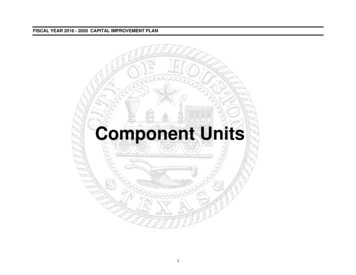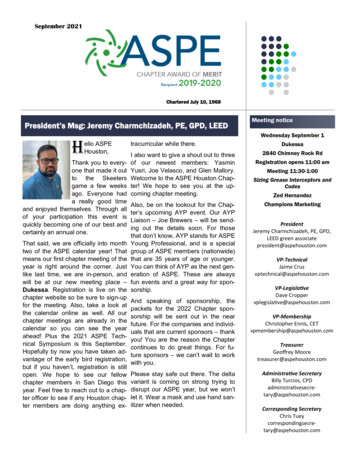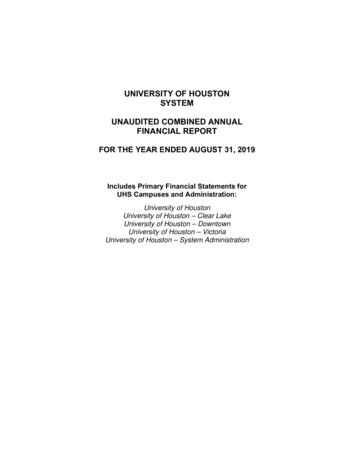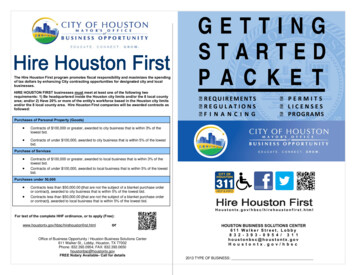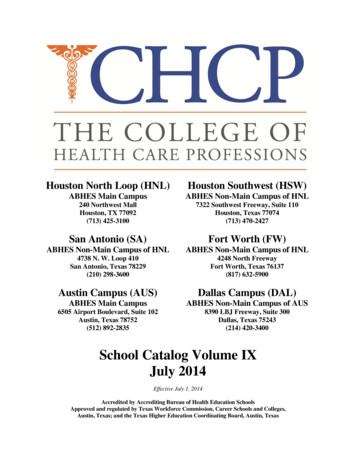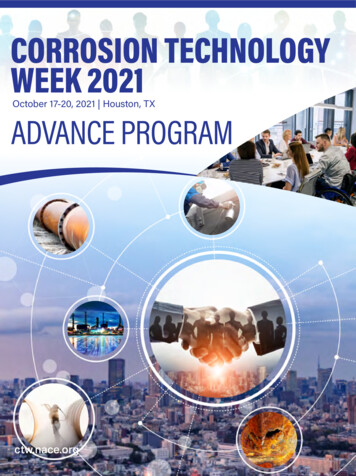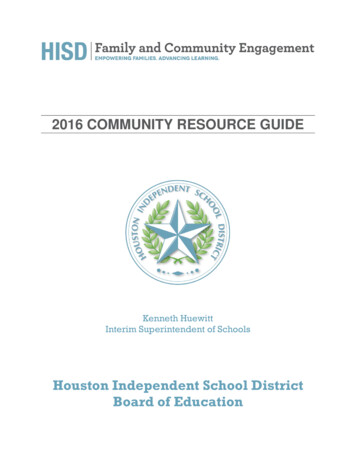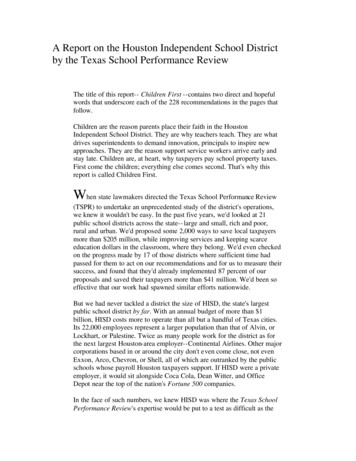
Transcription
A Report on the Houston Independent School Districtby the Texas School Performance ReviewThe title of this report-- Children First --contains two direct and hopefulwords that underscore each of the 228 recommendations in the pages thatfollow.Children are the reason parents place their faith in the HoustonIndependent School District. They are why teachers teach. They are whatdrives superintendents to demand innovation, principals to inspire newapproaches. They are the reason support service workers arrive early andstay late. Children are, at heart, why taxpayers pay school property taxes.First come the children; everything else comes second. That's why thisreport is called Children First.When state lawmakers directed the Texas School Performance Review(TSPR) to undertake an unprecedented study of the district's operations,we knew it wouldn't be easy. In the past five years, we'd looked at 21public school districts across the state-- large and small, rich and poor,rural and urban. We'd proposed some 2,000 ways to save local taxpayersmore than 205 million, while improving services and keeping scarceeducation dollars in the classroom, where they belong. We'd even checkedon the progress made by 17 of those districts where sufficient time hadpassed for them to act on our recommendations and for us to measure theirsuccess, and found that they'd already implemented 87 percent of ourproposals and saved their taxpayers more than 41 million. We'd been soeffective that our work had spawned similar efforts nationwide.But we had never tackled a district the size of HISD, the state's largestpublic school district by far. With an annual budget of more than 1billion, HISD costs more to operate than all but a handful of Texas cities.Its 22,000 employees represent a larger population than that of Alvin, orLockhart, or Palestine. Twice as many people work for the district as forthe next largest Houston-area employer--Continental Airlines. Other majorcorporations based in or around the city don't even come close, not evenExxon, Arco, Chevron, or Shell, all of which are outranked by the publicschools whose payroll Houston taxpayers support. If HISD were a privateemployer, it would sit alongside Coca Cola, Dean Witter, and OfficeDepot near the top of the nation's Fortune 500 companies.In the face of such numbers, we knew HISD was where the Texas SchoolPerformance Review's expertise would be put to a test as difficult as the
final exams taken each year by students from one end of the district to theother.Consider this: more than 205,000 students attend classes on 272 campusesspread across 312 square miles, an area almost half the size of Houstonitself. They converge each day on 1,500 classrooms, where nearly 12,000dedicated teachers and 1,900 teacher's aides, supported by administrators,custodians, clerical staff, and education professionals in every field refuseto believe that they're helpless against such odds.To an outsider, it might seem a miracle that so much could beaccomplished in a district of such size. But make no mistake--in theHouston Independent School District, thousands of little miracles occurevery day.Children come to classes from the Bayou City's wealthiest enclaves, fromits working-class sections, and from its most impoverished neighborhoods.They come not just because state law or their parents require them toattend, but for a reason far more compelling than that. They come to learn.Day after day, hour after hour, Houston's children arrive on campuses tofind intellectual challenges, personal support and, sometimes, a little bit ofinspiration. They come in the time- honored tradition that has drawngenerations--the belief that a sound public education can ignite the spiritand lead to a productive, prosperous life.Savannah smilesOpen the door to Room 14 at Louisa May Alcott Elementary School, forexample, and you'll catch a glimpse of one of the best possible educationallaboratories. Some 35 children in Mrs. Smith's fifth- grade class, neatlydressed in blue and white uniforms, greet visitors politely and recite poetryin unison. They eagerly demonstrate their classroom work stations, whichare geared to teaching the names and locations of each state, as well as toadding, subtracting, and multiplying numbers--not to mention readingstories carefully aligned with the state's curricular expectations and thedemands of the Texas Assessment of Academic Skills.Stay a little longer, and you'll hear 11- year-old Savannah Daniel praise herteacher."She always wants you to be somebody," Savannah says.A moment later, she pipes up again, suggesting that every child can learnanything there is to learn--anything."If you believe, you can do it," she says. "If you believe, you can do it."
Like Mrs. Smith, HISD's best teachers and their supporting cast instill andreinforce Savannah's kind of faith on a daily basis. During our stay, wemet few district employees who didn't place the interests of Savannah andthe other children of HISD above all else. The district's teachers especiallyknow that Houston's students try hard and that their parents harbor afervent desire to ensure a quality education for their kids.There are exceptions, of course; children who've gone astray and parentswho pay no attention, teachers who've lost touc h with their originalenthusiasm, and administrators who've mistakenly concluded that theirtrue customer is HISD's bureaucracy, rather than its students.But a high school English teacher expressed what seemed to be an opinionthat resonates among the majority of her colleagues."These are good kids," she assured us. "These are good, good kids."During our six months in HISD, we found few who disagree. Our surveys,our visits, our careful observations all persuaded us that no one blames thechildren for whatever problems exist in the district.In fact, it was heartening to discover the depth and breadth of the district'scommitment to the basic principle that public school teachers andadministrators should serve their children. This commitment is palpable-not just on paper, but through measurable deeds. If nothing else, the bestHISD schools put children first. And as long as teachers, administrators,support staff, and parents stay focused on those two words, the schoolswill continue to make a positive difference in the lives of the students whopass through its halls.That's why this report goes beyond our usual school performance review.While we've once again emphasized taxpayers' savings and suggestedspecific strategies to help the district operate more effectively andefficiently, we've tried to do something else, too. We've guided ourselvesby HISD's own ambitious goals, measuring each of our proposals by thestandards district leaders have proclaimed as their priorities in suchprevious documents as Declaration of Beliefs and Visions and Blueprint:Houston Schools of Excellence. We've considered the potential for thisvast enterprise to break new ground for large urban schools across thestate and the nation in their common of goal of educational excellence.And we've done so with a shared belief that out of every little miracle, outof each child who sets foot in an HISD classroom when the morning bellrings, anything is possible. Anything is possible if we keep SavannahDaniel's young aspirations in mind. Anything is possible as long as wekeep putting children first.
157 years of challengesThroughout history, Houston schools have faced down challenges andworked hard to keep up with the changing needs of the people they serve.The city's first free school opened for classes in 1839 in a building on thepresent site of the Houston Chronicle. By 1877, there were at least 14additional campuses. That year, the city assumed control of the schools,spending all of 11,850 to operate them (an amount that would fund fewerthan two-and-a-half students at the district's current annual operatingbudget of 4,992 per pupil).Not everyone was impressed, even back then. As the Houston Telegraph,an influential daily, editorialized on May 3, 1876, "[F]ree schoolscommenced all over the city yesterday. What a farce they are under thepresent law--or rather what a farce the law is. Teachers get 10 cents a dayfor each day that each pupil attends. When it rains, and only half thechildren attend school, the teacher has to work just as hard as usual on halfrations of pay. And they won't last over two or three months at most."In response, the 1923 Texas Legislature created the Houston IndependentSchool District, a separate system under the aegis of an elected board oftrustees. Through the end of that decade, voters approved three successivebond issues to renovate buildings or build new ones. Schools expanded ata rate that mirrored the city's own growth, and residents rushed to keeppace with their children's growing needs.Today, as the nation's sixth- largest public school district, HISD faceschallenges that couldn't have been imagined a century ago--although in atleast one sense, those challenges may seem all too familiar. In 1881, forexample, regulations warned that, "[P]upils are prohibited from carryingpistols, knives, black jacks or other deadly weapons to school. Anyonediscovered is liable to expulsion." In 1996, HISD board policies state:"Students have the responsibility not to carry on their person or to have onschool property or at school-sponsored events such items as drugs,weapons, alcohol, pagers or other contraband materials in violation ofschool policy or state law."In countless other ways, the challenges are different. Nearly 60 percent ofstudents in HISD schools today come from economically disadvantagedhouseholds. Growing numbers of six-year-olds arrive for first-gradeclasses lacking a basic vocabulary, unaware of the rudiments of groupbehavior, unfamiliar with books, often mesmerized by the lure of TV.Although the district's dropout rate in 1994-95 was down from the yearbefore, it's still more than twice as high as the statewide average. Exactly83,795 students districtwide were enrolled last year in grades 7 through 12when classes began; by the time commencement exercises rolled around,3,091 were not to be found.
Nor is HISD alone. Students in urban school districts nationwide mustadjust to challenges that barely existed a mere two decades ago. Dropoutrates in urban schools are 67 percent higher than in suburban or ruralschools. Teacher shortages are nearly three times as severe. More than halfof all urban school students come from single-parent homes. Big-cityschools are now asked to feed the hungry, teach the ills of drug andalcohol abuse, and address such modern-day realities as AIDS andhomelessness."Urban schools are overwhelmed by nonacademic problems," onesuperintendent recently told Congress. "We in the schools become thereceptacle and the recipient for the failures of every other single institutionin America."Few HISD teachers, administrators, support staff, or taxpayers couldquibble with that. No longer are Houston schools part of an interlockingset of institutions and relationships in a stable community. No longer dothey fit into a way of life in which all sidewalks are safe, all householdshave a parent waiting at home when school lets out, and all neighbors canbe counted on to keep an eye on everyone else's kids. The predictabilitywe once counted on as a society has given way to different kinds of familylife, increasing mobility, and shifting personal mores.While many of the challenges facing large urban school districts likeHISD lie beyond the scope of this report, we disagree with those whoargue that TSPR shouldn't "meddle" in Houston's educational affairs. Eventhough we didn't ask to conduct this performance review--we weredirected to do so by state lawmakers under the leadership of Senator JohnWhitmire --we believe that all of us have not just the right but theobligation to "meddle" in our public schools, to turn ourselves intoinformed, demanding consumers of what is undeniably our most importantproduct.Texas School Performance ReviewIt was with that attitude that the Texas School Performance Reviewstepped into this new world. Created in 1991, TSPR accepts invitationsfrom public school districts of any size in any part of the state. We settle infor months of detailed study, at no charge to district taxpayers. With thehelp of outside management experts, we consult a wide range ofadministrators, principals, teachers, parents, community groups, andbusiness leaders. We solicit suggestions from front- line employees and thedistrict's own students. We hold town meetings, public hearings, and focusgroup sessions. We encourage everyone to call our special toll- free hotlineand tell us what they think.
In the case of HISD, we did all this and more. Hundreds of peopleattended at least one community meeting held in each of the area districts.Hundreds more attended 23 special sessions, including volunteer andyouth groups, professional and business organizations, site-baseddecision- making committees, and leaders of minority communities. Othersresponded to public surveys published in Houston newspapers, and morethan 4,100 participated in telephone surveys. Still others replied to120,000 flyers sent home with students by calling their best ideas forsaving money or improving services to the toll- free hotline or via e- mailto hisd.cpa@cpa.state.tx.us, the Comptroller's special on-line address.As with all our reports, our best recommendations came from teachers,parents, students, and others who live or work in the district. Many ofthem had known for years what would help them improve their schools orreceive better service, if only someone would ask. We asked.It's important to note that we didn't conduct a financial audit in thetraditional sense. This performance review wasn't intended to find fiscalshenanigans or other potential criminal activities, nor did we uncover anyevidence of the kind. Instead, our mission was to try to identify ways thatHISD can accomplish more with the same amount of money--or even less.In the pages ahead, we recommend improvements in a dozen areas ofoperations, including district organization and management, communityinvolvement, educational services delivery, facilities, personnel, food andtransportation, information services, purchasing and warehousing, safetyand security, asset and risk management, and financia l affairs.Many of our recommendations aren't simply cost-saving measures noreasily quantifiable in dollars. Indeed, some have no direct fiscal effect atall, while others actually entail increased spending to attract greater publicor private funds.We fully expect Children First to elicit a mixed response. After all, whilesome of our previous reports have prompted school leaders to signal theirsupport early on and ultimately go above and beyond our proposals tomake improvements in areas not even suggested, others have been aboutas welcome as fire ants at a picnic. Even the most well- intentionedprofessionals sometimes resent "outsiders" looking over their shoulders.Yet, even in those districts where our work has received a lukewarmreception, officia ls have eventually come to recognize the value of ourproposals and the results they could achieve by implementing them. Somehave even learned that our reports can be a useful tool. A third party, itturns out, is often able to touch on certain "untouchable" topics--a foilagainst the inevitable backlash of unpopular, though necessary, changes.
But by acting on our proposals, all of the districts TSPR has previouslyreviewed have managed to cut their costs and improve their operations.We believe that if HISD officials give the suggestions in this report theirmost serious consideration, they can achieve even more dramatic savingsfor local taxpayers, streamline internal operations to make them moreeffective, and help secure continued public support for the district'sschools for years to come.Catalyst for changeThere isn't space enough in this brief summary volume to discuss each ofour 228 recommendations in detail. That's what we do in theaccompanying volume, where interested readers will find a comp letediscussion of the background leading to every proposal and a carefulstrategy for implementing each of the changes we have in mind.Here, we've settled for highlighting a few of the most importantrecommendations, underscoring others and taking an look at how thechallenges HISD faces can be embraced and turned to the district'sadvantage--if, as we know to be the case, district leaders are committed tofundamental change. We believe this report can serve as a catalyst for thatchange and a blueprint for a new era of hope, opportunity, andachievement in Houston's public schools.TSPR is more than a cookie-cutter operation. Rather than use astandardized recipe for our proposals, we try to approach each new districtwith creativity, innovation, and a thorough understanding of localexpectations, as well as the unique challenges that, inevitably, are madeclear during our work.Finally, we hope Children First sparks similar efforts in other schooldistricts to test and develop their own agendas for improving services andsaving taxpayers money. HISD is so large, so diverse that it contains allthe challenges faced by other school districts only more so--from theimmigration issues associated with districts in South Texas to the need forwater conservation more commonly considered a West Texas imperative.And we've identified many of HISD's exemplary practices and highlightedthem in this report so that other districts can take a look and see if theymight be adapted to their own needs.At a time when all Te xas schools face the critical challenge of how to payfor the education they deliver, we believe taxpayers deserve to know thattheir public schools are being held accountable for both the quality and thecost of that education. Only then will taxpayers in Houston and across thestate be willing to invest the time, energy, and dollars necessary to putchildren first each day of each school year, now and in the years ahead.
I Am The Best Child I Can BeI am the best child I can beO, dear teacher, please help me to seeThe best, the most, the greatness in me.I want to be somebody specialI want to know my great potentialI want to do something beneficial.I want to know my special skills,I want to do things to fulfillMyself, my being, my good will.I want to make, produce, and give.I want to feel, to love, to live.I just hope the one that's teachingPromotes my goodness with her speakingProudly teaching and outreaching.I am the best child that I can be,O, dear teacher, please help me to seeThe best, the most, the greatness in me.-- Bernice BranfordThis poem was recited from memory by students in Mrs. Beverly Smith'sfifth- grade class at Louisa Alcott Elementary to an unexpected visitorfrom the Texas School Performance Review team. Inspired by the poem,the class is composing its own poem. Mrs. Smith said she acquired thepoem during her student teaching days.
Chapter 1: District Administration/CommunityInvolvementStreamlining CentralBureaucracy, RetoolingBoard PoliciesKey recommendations: Eliminate 320 non-teaching positionsRetool HISD Board policies to stop micro- managementStop paying teachers no t to teachReduce the size of the communications and public relations staffand shift their focus from image-building to providing clear andaccurate public information"They should stop worrying about who's running the district and startfixing it."--HISD 8th grade studentHow many HISD students spend their time thinking about how theirschool district is organized? How many wonder whether the central officestaff is too big or the interest earnings from the district's financialinvestments too small? How many worry that millions in delinquentschool taxes may go uncollected, that myriad minor decisions may occupyboard members' time, or that a perceived lack of accountability amongadministrators has eroded community support for their schools?How many students ponder these questions? More than you might think. "They should pay more attention to the students and how wellthey're doing on academics," one HISD student told the TSPRteam."Reduce administrative staff, middle management and the centralbureaucracy," another suggested."When HISD can learn how to weed out its bloated bureaucracy,they can begin to get some respect from the citizenry," yet anotherargued.
Countless others, from elementary students to high school seniors, hadsimilar things to say. Their comments were echoed by parents, teachers,district employees, and taxpayers.Every large bureaucracy can stand a little shaking up now and then. Eventhe most efficient school administration will begin to allow "titleinflation," "position creep," or other mid- and high- level bloat if thepeople who foot the bills stop paying attention, or district leaders aren'tlistening to their customers.HISD is a large bureaucracy. And the people who foot the bills--alongwith many of their children--are paying attention. District leaders shouldstart listening.Central AdministrationEach public school district's objectives call for a different approach, andeach district's optimum organizational scheme must be tailoredspecifically to its own needs. That's the essence of local control.Decentralization, a hallmark of HISD's efforts over the past few years,should have resulted in less central administration. Yet, centraladministration's costs have grown more than 14 percent in the past year,up from 104.4 million to 119.3 million. That's an increase of 14.9million in one year--even as five new area district offices were added aspart of the decentralization effort. Clearly, someone has forgotten toreduce the central bureaucracy.Time after time, in a series of public surveys and community meetings,TSPR heard comments about the size of the district's central bureaucracy.These opinions, expressed by a wide range of teachers, district employees,and taxpayers, lead to an inescapable conclusion: when it comes to thesize and cost of its central administration, HISD has more than just animage problem. It has too much bureaucracy.As a direct result of early conversations with the TSPR team during thecourse of this review, HISD officials have begun to implementreorganization plans during the past month. We commend them for theseefforts. As with our reviews of other public school districts, we'll be backin a few months to measure their performance and commitment to ongoingreforms.Meanwhile, putting the district's central administration on a fat-free diet islikely to be a difficult, painstaking process. Entrenched mid- levelbureaucrats can be remarkably resistant to change. Some standard bearersof the status quo have learned through the years to fend off efforts toimprove efficiency. As in any bureaucracy, there are canny turf defenders
who have developed an uncanny knack for serving their own needs, ratherthan the needs of their customers.But most HISD employees are talented, well- meaning people. If they aretoo often hamstrung by illogical procedures, pulled in unproductivedirections by outmoded polices, or trapped in a system that inspires littleinnovation, that's no reason to reject the possibility of reform. Thedistrict's chain-of-command is the network through which its goals arecommunicated and achieved. Unnecessary layers of bureaucracy that limitthe direct link of principals, teachers, and others to HISD's decisionmakers must be removed.As an impartial observer, TSPR has the autonomy to recommend toughdecisions. That's why Children First presents a package of proposals tostreamline the ranks of the district's central bureaucracy by 114 currentpositions, including 17 assistant superintendents. These proposals willflatten the district's management structure and reduce central office staff,saving 1.3 million this year--and more than 22 million over the next fiveyears.Micro-managing by the boardAnother frequent complaint about HISD is that the nine-member HoustonBoard of Education pays too much attention to routine business andpersonnel matters, and not enough attention to setting the district's overalleducation policies and priorities.An analysis of board meeting agendas during a recent nine-month periodfound that 81 percent of the items occupying board members' time had todo with awarding contracts for even minor campus construction ormaintenance, land acquisition, purchasing, and personnel matters. Onlyabout 15 percent of the board- meeting items during that time requiredmembers to deliberate on education policies.An example: There have been more than 21,000 transfers of HISD fundsfrom one account to another already this year--each of them, by state law,requiring the board's approval. If HISD, during the budget process, wouldguide itself by established historical patterns of where funding is neededas the school year progresses, the district could dramatically cut thenumber of fund transfers each year. Then, board members could focus oneducation policy.Another examp le: state law calls for board approval of purchases greaterthan 25,000. HISD policy, however, directs board members to approveall purchases over 10,000. Last year, the board reviewed 889 formal bidsfor items costing more than 10,000 but less than 25,000. Thisunnecessary addition to the board's workload--these were decisions best
left to the district's management--cost taxpayers 25,500. And itrepresented another diversion of board members' attention from the largerissues of educational excellence.Yet another example of how board practices are often worse than boardpolicies: board members involve themselves in an inordinate number oflow- level personnel matters that should be handled by district managers.This practice not only violates the board's own policies, but it also wastesthe time of district administrators, who must constantly respond and reactto board members' requests for background materials. In addition, thesemeddlesome ways have left board members open to allegations ofwielding undue influence over personnel and contracting matters.Imagine a big business in which the board of directors hired and fired thecompany's employees, while the CEO was left to sit on the sidelines andwatch. In HISD, the superintendent must be allowed to control hiring andfiring, instead of the board, whose power and duties under state law areexpressly limited to hiring the superintendent and issues of broadeducation policy.Oversight is one thing. In a district the size of HISD, with more than 1billion of public funds at stake each year, strict attention to business andfinancial matters is critical. But micro-management is another thingaltogether. The overall mission of the HISD board is to set policies thatoffer students in the district's classrooms a high-quality, low-costeducation. Undue attention to the day-to-day decisions on individualcampuses is an inefficient use of board members' time, a violation of theirown policies, and a continuously disruptive influence on the professionalswho are paid by taxpayers to perform those functions for the district.Children First recommends a comprehensive review of existing policiesand a structure of standing committees to provide the board an appropriateavenue for setting new policies--the express power and duty granted theboard under the state's education code--while leaving districtadministrators free to carry out those policies on a daily basis.Paying teachers not to teachRemember how you felt when you first learned that the U.S. governmentwas paying farmers not to farm? Well, HISD is paying teachers not toteach and workers not to work. The district is hiring employees for jobsthat don't yet exist, and still rewarding a former area superintendent withfull pay--more than 80,000 a year--six months after he was supposedlyfired for poor performance.This practice of paying employees who don't have job assignments, orwho are no longer doing the job they were hired to do, costs taxpayers 1
million a year. Three district policies are the culprits: "temporaryassignment," "awaiting assignment," and the School of Abatement."Temporary assignment" is used for those who are awaiting hearings ondisciplinary charges or other matters. At last count, there were 10employees in this category. "Awaiting assignment" is used for teachersand others who are hired but for whom no budgeted job exists. At lastcount, there were 28 employees in this category, down from 42 a year ago.However, district policies of hiring teachers and placing them inclassrooms prior to final enrollment counts causes the number of peopleawaiting assignment to fluctuate in cycles. The current number is the lowpoint of the cycle and will almost certainly rise by January.One teacher in the awaiting assignment category told TSPR he hadn'ttaught since the beginning of the month and had spent each day "readingnewspapers in the lounge."Finally, there's the famous School of Abatement. This device, used at thediscretion of board members, allows certain employees to stay on thepayroll for a variety of reasons even though they are no longer doing thejob. Two non-working employees are currently assigned to the school,down from nine three years ago.Children First strongly urges HISD to stop paying people who don't havejobs and, in some cases, don't even bother to show up. District policiesthat contribute to these situation should be thoroughly reviewed, includingpaying accrued sick leave upon termination, and allowing administratorsfired under the performance contract system to collect up to a year's salaryand extra bonus money on their way out the door.The extended process for terminating employees should be retooled. HISDshould have the ability, under clear policies, to fire incompetent or poorlyperforming employees.The process by which enrollment is projected and teachers are hired at thebeginning of ea
schools whose payroll Houston taxpayers support. If HISD were a private employer, it would sit alongside Coca Cola, Dean Witter, and Office Depot near the top of the nation's Fortune 500 companies. In the face of such numbers, we knew HISD was where the Texas School Performance Review's expertise would be put to a test as difficult as the
